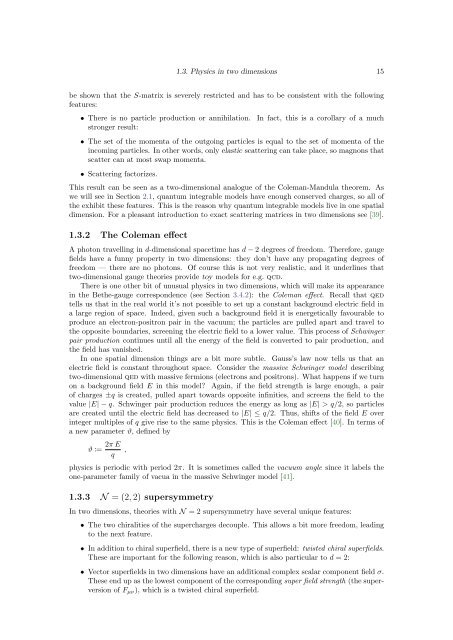The Bethe/Gauge Correspondence
The Bethe/Gauge Correspondence
The Bethe/Gauge Correspondence
You also want an ePaper? Increase the reach of your titles
YUMPU automatically turns print PDFs into web optimized ePapers that Google loves.
1.3. Physics in two dimensions 15be shown that the S-matrix is severely restricted and has to be consistent with the followingfeatures:• <strong>The</strong>re is no particle production or annihilation.stronger result:In fact, this is a corollary of a much• <strong>The</strong> set of the momenta of the outgoing particles is equal to the set of momenta of theincoming particles. In other words, only elastic scattering can take place, so magnons thatscatter can at most swap momenta.• Scattering factorizes.This result can be seen as a two-dimensional analogue of the Coleman-Mandula theorem. Aswe will see in Section 2.1, quantum integrable models have enough conserved charges, so all ofthe exhibit these features. This is the reason why quantum integrable models live in one spatialdimension. For a pleasant introduction to exact scattering matrices in two dimensions see [39].1.3.2 <strong>The</strong> Coleman effectA photon travelling in d-dimensional spacetime has d − 2 degrees of freedom. <strong>The</strong>refore, gaugefields have a funny property in two dimensions: they don’t have any propagating degrees offreedom — there are no photons. Of course this is not very realistic, and it underlines thattwo-dimensional gauge theories provide toy models for e.g. qcd.<strong>The</strong>re is one other bit of unusual physics in two dimensions, which will make its appearancein the <strong>Bethe</strong>-gauge correspondence (see Section 3.4.2): the Coleman effect. Recall that qedtells us that in the real world it’s not possible to set up a constant background electric field ina large region of space. Indeed, given such a background field it is energetically favourable toproduce an electron-positron pair in the vacuum; the particles are pulled apart and travel tothe opposite boundaries, screening the electric field to a lower value. This process of Schwingerpair production continues until all the energy of the field is converted to pair production, andthe field has vanished.In one spatial dimension things are a bit more subtle. Gauss’s law now tells us that anelectric field is constant throughout space. Consider the massive Schwinger model describingtwo-dimensional qed with massive fermions (electrons and positrons). What happens if we turnon a background field E in this model? Again, if the field strength is large enough, a pairof charges ±q is created, pulled apart towards opposite infinities, and screens the field to thevalue |E| − q. Schwinger pair production reduces the energy as long as |E| > q/2, so particlesare created until the electric field has decreased to |E| ≤ q/2. Thus, shifts of the field E overinteger multiples of q give rise to the same physics. This is the Coleman effect [40]. In terms ofa new parameter ϑ, defined byϑ := 2π Eq,physics is periodic with period 2π. It is sometimes called the vacuum angle since it labels theone-parameter family of vacua in the massive Schwinger model [41].1.3.3 N = (2, 2) supersymmetryIn two dimensions, theories with N = 2 supersymmetry have several unique features:• <strong>The</strong> two chiralities of the supercharges decouple. This allows a bit more freedom, leadingto the next feature.• In addition to chiral superfield, there is a new type of superfield: twisted chiral superfields.<strong>The</strong>se are important for the following reason, which is also particular to d = 2:• Vector superfields in two dimensions have an additional complex scalar component field σ.<strong>The</strong>se end up as the lowest component of the corresponding super field strength (the superversionof F µν ), which is a twisted chiral superfield.
















